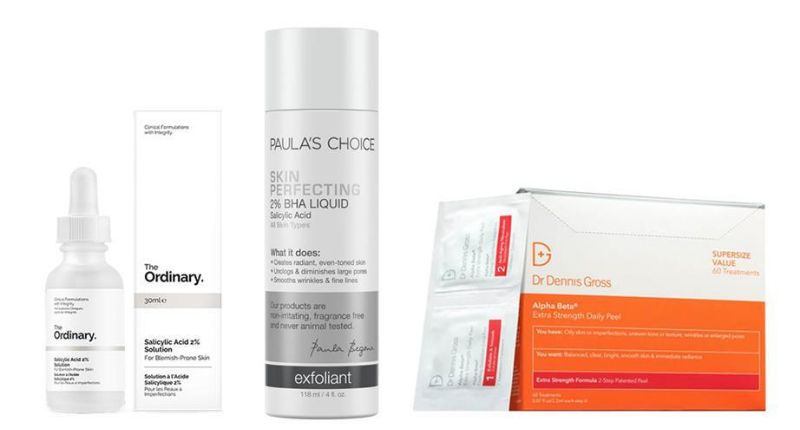Salicylic acid is a great ingredient to fight acne and excessive oil. It works to clear your skin of all kinds of blemishes and woes. You can use it all over your body, for poison ivy and bug bites, even as a spot treatment to get rid of those pimples you have been wanting to get rid of for ages. Salicylic acid is a common ingredient in skin-care products. While it’s highly effective, it can cause irritation and side effects. We’ll explain everything you need to know about using salicylic acid on your face.
1.What are the benefits of salicylic acid for your skin?
Salicylic acid is a beta-hydroxy acid (BHA), which is a type of exfoliating acid. The other type is alpha hydroxy acid (AHA), which includes ingredients such as glycolic and lactic acid. Salicylic acid is an FDA approved skin care ingredient used for the topical treatment of acne, and it is the only BHA used in skin care products.
Salicylic acid is a good option for people with oily skin and removes excess oil from the pores, prevent blackhead, acne and pimples. Salicylic acid can reduce the oil discharge of pores, preventing acne and pimples. Salicylic Acid is the active ingredient in many acne treatments, and it prevents blackheads by unblocking pores. In addition to acne treatment, salicylic acid is also used to treat psoriasis as its anti-inflammatory properties make it a major component for the treatment.
· Loosens dead skin cells
Salicylic acid is an exfoliant that can remove dead skin cells by chemically exfoliating the top layer of skin and accelerate skin cell renewal. Furthermore, salicylic acid is a desmolytic, which loosens the bonds between corneocytes (the cells that make up the outermost layer of the skin). As a desmolytic, salicylic is a milder exfoliant than azelaic acid and benzoyl peroxide, both of which are keratolytic agents. Keratolytic can provide deeper exfoliation but may be more irritating to sensitive skin. All three ingredients are comedolytic, meaning they unclog pores and prevent future whiteheads and blackheads from developing.
· Cleans excess oil from pores
Perfect for oily skin, salicylic acid is known for its ability to clean up excess oil and reduce oil levels moving forward. Salicylic acid can exfoliate your pore lining and decrease oil buildup. Compared with other ingredients, salicylic acid can penetrate deeply into the pores of excess oil and dead skin, while other ingredients can only remove them from the top of the pores. Salicylic acid provides good deep cleansing and inhibits the production of excess oil by sebocytes from producing excess oil.
· Prevents the formulation of acne
As it is oil-soluble, salicylic acid can keep pores clean. Therefore, whiteheads and blackheads won’t develop from excess oil or dead skin cells nesting in your skin.
· Reduces inflammation
Salicylic acid is naturally found in willow bark and contains a chemical called salicin. Related to aspirin, salicin has anti-inflammatory properties that calm irritated, inflamed skin. In regards to acne, this could reduce redness, soreness, and puffiness.
· Weakens acne bacteria
Salicylic acid unclogs and exfoliates pores, fresh air gets into the skin and creates a more oxygen-rich environment that’s less friendly to acne bacteria. However, even if salicylic can unclog pores, it can’t get rid of acne entirely.
2.How to use salicylic in the correct way?
If at all possible, try to test the product on a small patch of skin before wearing it all over your face. Apply a small amount of salicylic acid product to a small forehead area at night to test if there is any irritation after 24 hours. Salicylic acid is best added into cleansers for gentle exfoliation or treatment essence to maintain the balance and control of acne-prone skin. If using the latter, note to only apply the serum directly to the area you want to treat – don’t slather it all over.
If you have sensitive skin, daily or regular use can potentially dry out or even damage your skin barrier. Additionally, no matter your skin type, avoid layering salicylic acid with any other acid-containing products without consulting an expert first. Similarly, you should also be mindful of the other active ingredients – such as retinol and antioxidants – in your skincare products.
Salicylic acid is a chemical exfoliant. It can loosen the dead skin cells on your skin’s surface without you having to scrub your skin to make it work. So don’t scrub! Let the product soak in and do its thing.
3.What are the side effects of salicylic acid?
Like many acids, overuse of salicylic or use in high concentration can leave your skin prone to irritation and redness. But other variables could come into play if your skin reacts negatively after use. Salicylic acid is FDA approved, and it’s safe for topical use in concentrations of up to 2% in skincare products. If you experience any of the following, stop using salicylic acid immediately.
· Dryness
· Itching, peeling
· Redness
· Purging within few weeks
4.What are the best salicylic productions to use?
There are many salicylic acid-based cleansers on the market which aims to clear your pores of congestion, as well as calm any redness. Try Mario Badescu’s Acne Facial Cleanser, Murad’s AHA/BHA Exfoliating Cleanser, or the Dermalogica Clearing Skin Wash.
If you have acne-prone skin, you probably want to substitute salicylic acid-based exfoliants to your care routine. The Ordinary’s Salicylic Acid 2% Solution, the Paula’s choice Skin Perfecting 2% BHA Liquid and Dr. Dennis Gross’s Alpha Beta Extra Strength Daily Peel are good options to try.
If your breakout requires a little overnight treatment action, you can’t go pass a spot treatment rich in salicylic acid. Try Mario Badescu’s cult-favourite Drying Lotion, the Alpha-H Clear Skin Blemish Control Gel or Origins’ Super Spot Remover Blemish Treatment Gel.







